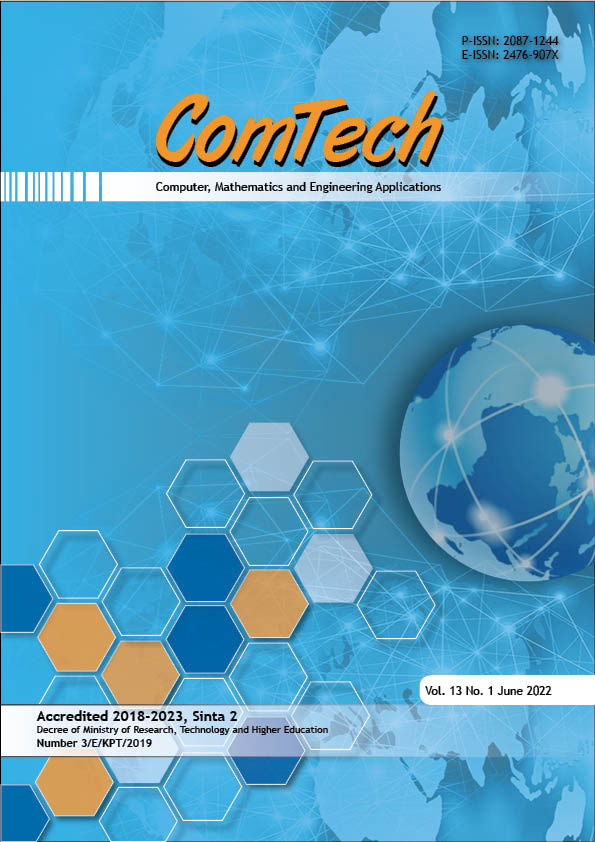The Application of C4.5 Algorithm for Selecting Scholarship Recipients
DOI:
https://doi.org/10.21512/comtech.v13i1.7307Keywords:
C4.5 algorithm, scholarship program, data mining, decision tree, data classificationAbstract
The scholarship program is one of the promotional techniques used by many universities, and the right scholarship award will certainly be an attraction for many people. STMIK Pelita Nusantara is one of the universities that organizes a scholarship program. In the current difficult economic conditions, the scholarship program is the target of many prospective students who want to continue their education in higher education. However, the absence of tools to process large amounts of data make determining scholarship recipients less effective and time-consuming. This situation is seen by the fact that some students are still unable to maintain the scholarships they receive. In the research, a classification model was proposed using the C4.5 algorithm approach by utilizing past data to facilitate the decision making of the scholarship program. This classification process produced a decision tree that could be used as a decision-making tool. Scholarships were awarded based on several criteria: academic potential, vocational potential, parents’ income, number of dependents, and employment status. Based on the data processing results of students who apply for scholarships in 2020 with predetermined criteria, the highest root is obtained. It consists of node 1 for academic potential, node 1.1 for vocational potential, and node 1.2 for parental income. The resulting decision tree model is expected to help to make decisions quickly and on target.
References
Afrianto, E., Suseno, J. E., & Warsito, B. (2020). Decision tree method with C4.5 algorithm for students classification who is entitled to receive Indonesian Smart Card (KIP). In IOP Conference Series: Materials Science and Engineering. IOP Publishing. https://doi.org/10.1088/1757-899X/879/1/012072
Ariawan, P. A. (2019). Optimasi pengelompokan data pada metode K-means dengan analisis outlier. Jurnal Nasional Teknologi & Sistem Informasi, 5(2), 88–95. https://doi.org/10.25077/teknosi.v5i2.2019.88-95
Azmi, Z., & Dahria, M. (2013). Decision tree berbasis algoritma untuk pengambilan keputusan. Jurnal SAINTIKOM, 12(3), 157–164.
Bedregal-Alpaca, N., Cornejo-Aparicio, V., Zárate-Valderrama, J., & Yanque-Churo, P. (2020). Classification models for determining types of academic risk and predicting dropout in university students. International Journal of Advanced Computer Science and Applications(IJACSA), 11(1), 266–272. https://doi.org/10.14569/ijacsa.2020.0110133
Condrobimo, A. R., Sano, A. V. D., & Nindito, H. (2016). The application of K-means algorithm for LQ45 index on Indonesia Stock Exchange. ComTech: Computer, Mathematics and Engineering Applications, 7(2), 151–159. https://doi.org/10.21512/comtech.v7i2.2256
Dardzinska, A., & Zdrodowska, M. (2020). Classification algorithms in the material science and engineering data mining techniques. In IOP Conference Series: Materials Science and Engineering. IOP Publishing. https://doi.org/10.1088/1757-899X/770/1/012096
Dhika, H., & Destiawati, F. (2015). Application of data mining algorithm to recipient of motorcycle installment. ComTech: Computer, Mathematics and Engineering Applications, 6(4), 569–579. https://doi.org/10.21512/comtech.v6i4.2192
Effendy, F., & Purbandini. (2018). Klasifikasi rumah tangga miskin menggunakan ordinal class classifier. Jurnal Nasional Teknologi & Sistem Informasi, 4(1), 30–36. https://doi.org/10.25077/teknosi.v4i1.2018.30-36
Fiandra, Y. A., Defit, S., & Yuhandri. (2017). Penerapan algoritma C4.5 untuk klasifikasi data rekam medis berdasarkan International Classification Diseases (ICD-10). Jurnal RESTI (Rekayasa Sistem dan Teknologi Informasi), 1(2), 82–89. https://doi.org/10.29207/resti.v1i2.48
Florence, A. M., & Savithri, R. (2013). Talent knowledge acquisition using C4. 5 classification algorithm. International Journal of Emerging Technologies in Computational and Applied Sciences (IJETCAS), 4(4), 406–410.
Guntur, M., Santony, J., & Yuhandri. (2018). Prediksi harga emas dengan menggunakan metode Naïve Bayes dalam investasi untuk meminimalisasi resiko. Jurnal RESTI (Rekayasa Sistem dan Teknologi Informasi), 2(1), 354–360. https://doi.org/10.29207/resti.v2i1.276
Haryati, S., Sudarsono, A., & Suryana, E. (2015). Implementasi data mining untuk memprediksi masa studi mahasiswa menggunakan algoritma C4.5 (Studi kasus: Universitas Dehasen Bengkulu). Jurnal Media Infotama, 11(2), 130–138.
Hidayad, A., Defit, S., & Sumijan, S. (2020). Penerapan algoritma K-means clustering untuk melihat hubungan kegiatan Tahfiz dengan hasil belajar (Studi kasus Madrasah Aliyah Negeri 1 Bukiktinggi). Jurnal Sistim Informasi dan Teknologi, 2(2), 41–47. https://doi.org/10.37034/jsisfotek.v2i2.34
Putra, R. A., & Defit, S. (2019). Data mining menggunakan rough set dalam menganalisa modal upah produksi pada industri seragam sekolah. Jurnal Sistim Informasi dan Teknologi, 1(4), 72–78. https://doi.org/10.35134/jsisfotek.v1i4.18
Rahmayuni, I. (2014). Perbandingan performansi algoritma C4.5 dan Cart dalam klasifiksi data nilai mahasiswa Prodi Teknik Komputer Politeknik Negeri Padang. Teknoif, 2(1), 40–46.
Riandari, F., & Simangunsong, A. (2019). Penerapan algoritma C4.5 untuk mengukur tingkat kepuasan mahasiswa. CV. Rudang Mayang.
Santoso, H., Hariyadi, I. P., & Prayitno. (2016). Data mining analisa pola pembelian produk dengan menggunakan metode algoritma Apriori. Semnasteknomedia Online, 4(1), 19–24.
Sulastri, H., & Gufroni, A. I. (2017). Penerapan data mining dalam pengelompokan penderita thalassaemia. Jurnal Nasional Teknologi & Sistem Informasi, 3(2), 299–305. https://doi.org/10.25077/teknosi.v3i2.2017.299-305
Virgo, I., Defit, S., & Yunus, Y. (2020). Klasterisasi tingkat kehadiran dosen menggunakan algoritma K-means clustering (Studi kasus Institut Agama Islam Batusangkar). Jurnal Sistim Informasi dan Teknologi, 2(1), 23–28. https://doi.org/10.37034/jsisfotek.v2i1.22
Downloads
Published
How to Cite
Issue
Section
License
Copyright (c) 2022 Fristi Riandari, Sarjon Defit

This work is licensed under a Creative Commons Attribution-ShareAlike 4.0 International License.
Authors who publish with this journal agree to the following terms:
a. Authors retain copyright and grant the journal right of first publication with the work simultaneously licensed under a Creative Commons Attribution License - Share Alike that allows others to share the work with an acknowledgment of the work's authorship and initial publication in this journal.
b. Authors are able to enter into separate, additional contractual arrangements for the non-exclusive distribution of the journal's published version of the work (e.g., post it to an institutional repository or publish it in a book), with an acknowledgment of its initial publication in this journal.
c. Authors are permitted and encouraged to post their work online (e.g., in institutional repositories or on their website) prior to and during the submission process, as it can lead to productive exchanges, as well as earlier and greater citation of published work.
 USER RIGHTS
 All articles published Open Access will be immediately and permanently free for everyone to read and download. We are continuously working with our author communities to select the best choice of license options, currently being defined for this journal as follows:




















